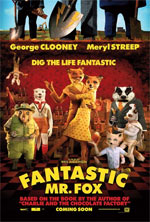
Fantastic Mr. Fox

 – for action, smoking and slang humor.
– for action, smoking and slang humor.
Director: Wes Anderson
Starring: voices of George Clooney, Bill Murray, Meryl Streep, Jason Schwartzman
Running Time: 1 hour, 27 minutes
Theatrical Release Date: November 25, 2009
Blu-Ray Release Date: March 23, 2010 (Amazon.com)
Website: fantasticmrfox.com
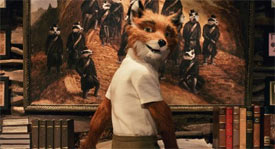
Plot Summary
“Fantastic Mr. Fox” is visionary director Wes Anderson’s first animated film, utilizing classic handmade stop motion techniques to tell the story of the best selling children’s book by Roald Dahl (author of Charlie and the Chocolate Factory and James and the Giant Peach). (from MovieWeb.com)
Film Review
It’s a surprise, to me at least, for an indie film director to decide to leave a string of oddball, R-rated films and chase after adapting a 1970 childrens book into a stop-motion animated PG-rated film. But that’s exactly what Wes Anderson, best known for his films Rushmore, The Life Acquatic, and The Royal Tenenbaums, has done. From the opening credits of Fantastic Mr. Fox, it’s no question that you’re watching a Wes Anderson film, and the director treats this picture like any other one of his films – with the dramatic closeups, unsual camera angles or
framing, and odd character behavior. Fantastic Mr. Fox is as off-beat as any other one of Anderson’s films, but it’s quite easily his best.
All of Anderson’s films (four of which I’ve seen – all in an edited, more sterile form by my own preference – for better or worse) have an approach that is undeniably an acquired taste. There’s a quirky humor style that Anderson embraces and embellishes that is welcomed by many indie film buffs but not so easily digestible by the pop film culture audience. I must fall into the latter category as the only film I’ve enjoyed by Anderson’s was the wacky Life Acquatic (again, in edited form), which still felt a bit too off-beat for my usual tastes. Fantastic Mr. Fox fares best of all of his work, possibly due to the source material, coupled with the fact it’s presented in a uniquely done stop-motion animation style. The end result is as entertaining to watch as it is to take in. Each character – from the animals to the humans – are interesting in design and character traits, and it’s these kinds of details that work to the film’s benefit.
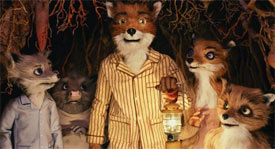
Still, when a film so off-beat and against the norm (but typical for this director) becomes so heavily lauded by the majority of film critics, you kind of go into viewing such a film with high expectations. And while my expectations may have been a bit unattainable, it’s still easy enough for me to grasp Fantastic Mr. Fox as a whole, stack it up against the widespread praise given towards the movie, and wonder what is SO extraodinarily different (or better?) than most other animated films? Sure, there isn’t a single other animated film like this out there, but if you know Anderson’s work, this one follows suit perfectly. While his other live action films have always been adult-oriented in nature, this orientation even carries over a bit into Anderson’s first all-animation PG-film. For example, instead of there being lots of profanity as might usually be found in some of Anderson’s work, the director makes up for it with substitute profanity. Oddly enough, where a character might usually use any number of profanities – including the “f” word – the characters in Fantastic Mr. Fox quite regularly, and simply, substitute the word “cuss” in place of it. They
might say, for example, “What the cuss was I thinking?” instead of something much more profane. Even though it’s not the actual word, you often get the idea what they would normally say there, and so it feels a bit harsh or out of place for such a film. Also, at first it seemed like a clever idea, but by the film’s end, so many characters do this, and so often, that it feels over-used and a bit tired. But the very fact that Anderson even chooses to go this route with the dialog kind of cements the realization that Fantastic Mr. Fox isn’t really a kids film.
Sure, Fantastic Mr. Fox involves a central family of characters who are personified foxes who wear clothes, and, yes, other characters include badgers, rabbits, possums, and the like, but the plot involves stealing, drinking, smoking, and ruthless farmers trying to kill and wipe out the food pilfering animals. Fantastic Mr. Fox is about as edgy as you might expect a Wes Anderson animated film to be, and with there even being some pretty creepy-to-frightening scenes for young ones, it’s just not really a suitable family film. And that’s not even mentioning the slower pace of the film that is likely to lull the younger ones to sleep in their seats (or make them too antsy to sit through its just-under 90-minute running time). So the question is raised: just who is this animated PG film targeted to? Sadly, the opening weekend holiday box office take of just $10 million relates that this may be the very problem with it.
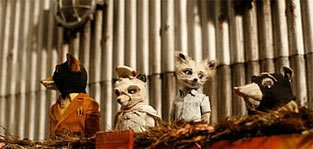
But all this isn’t to say that Fantastic Mr. Fox is a bad film. By this point in the review, I’m sure you’re wondering why on earth I gave the film rather positive marks. Truth is, Anderson has put together a fine looking and rather fun heist film. Casting George Clooney in the role of Mr. Fox is quite inspired, considering Fox feels like a sort of scheming Cary Grant character and Clooney clearly has emulated Grant’s style more than once before (see Leatherheads especially). And with Clooney having previously played the role of heist mastermind Danny Ocean in Ocean’s 11 and its two sequels, Mr. Fox doesn’t stray too far from George’s comfort zone. The film brings up some interesting themes in the story that include children feeling like they can’t measure up to their peers and parents needing to encourage their children and not hold such high expectations for them. Team that with some silly, out of left field humor and indie-style directing and you have one bizarre animated film. Fans of Anderson’s work are likely to enjoy this one the most, while those who kind of like to play it safe and usually only enjoy the blockbuster popcorn entertainment may want to skip this one.
Aside from the “cuss” substitute profanity, there are some violent scenes that include an animal getting its tail shot off (we see the dismembered tail a few times, as well as the animal’s bandaged up wound), an animal scratches another animal’s face during a serious argument, and there are other instances that involve a rabid dog, sinister-looking farmers shooting relentlessly at their animal victims (with intent to kill, of course), and a creepy rat (appropriately voiced by the equally creepy Willem Dafoe) who wields a switch blade and threatens our heroes a few times.
Fantastic Mr. Fox is certainly one of the more unique animated films to be released this year. Indie film director Wes Anderson transfers his quirky adult filmmaking style into stop-motion form and it actually works for the most part. While this style will indeed limit the film’s audience, it’s rather evident that Anderson was only concerned with making a film for his fans and older viewers alike than making a film for a wider audience. With that in mind, Fantastic Mr. Fox is a fun little film, but not one for the young ones, and not your usual family fair.
– John DiBiase, (reviewed: 12/3/09)
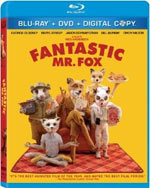
Blu-Ray Special Features Review
One might look at a stop-motion film like Fantastic Mr. Fox and feel like this isn’t exactly a must-see in High Definition. But to make such an assumption would be an unfortunate mistake. One of the most notable things while watching Fantastic Mr. Fox is the intense attention to detail. I can recall sitting in the theater and marveling at all must have gone into the claymation feature Chicken Run, back in 2000, but even that pales a bit in comparison to the incredible detail in Fantastic Mr. Fox. This is a film for artists and fans of independent films indeed. Director Wes Anderson has never before made such an accessible film for movie goers of all ages, and he does a pretty good job in his attempt to bring the Roald Dahl classic book to the big screen. The only concerns, as I mentioned in our theatrical review from December, is the violence in the film as well as the frequent use of the word “cuss” in places where the usual strong profanity would be used. The entire execution of the film is more adult than for children, which may make some wonder just who this animated film is intended for. However, upon watching it again on home video – and in high definition – the film does contain strong themes about family and emphasizing our individual talents and strengths. On top of that, it’s just a wonderful film visually, and to see the tiniest details in the art in such clarity really does the film justice.
The Blu-Ray features take the viewers well beyond the film which, in all honesty, lives up to the description of “fantastic.” Making Mr. Fox Fantastic (44:48) is a six-part featurette that takes the viewer into how the incredible stop motion world of Mr. Fox was created. We see a lot of behind the scenes glimpses into the making of the puppets, the actual filming process, how each piece of set dressing and each prop was hand made and tailored to the world of Mr. Fox. We even get a chance to hear author Roald Dahl’s wife Felicity talk about Roald’s story and Wes Anderson’s treatment of it. The “From Script To Screen” chapter gives us a look at the original book and the illustrations that accompanied it, which all were used as inspiration for the final product. One of the most surprising aspects to the making of the film is the insight into the fact that Anderson filmed voice actors George Clooney, as well as Bill Murray and a few others, acting out some of their scenes in person – on location on a farm or in an office – to capture their voices for the film in the process. It was neat to see such candid b-roll footage included. The only thing that really seemed to be missing from this extensive featurette was actual interview footage with Clooney, Meryl Streep, and other voice actors in the film. We do, however, get some screen time with Jason Schwartzman, who voiced the littlest Fox, Ash, and Bill Murray who voiced Mr. Fox’s lawyer, Badger. All in all, this was a great inside look into the making of the film and it helped build appreciation for all the animators’ efforts. At just a few seconds under forty five minutes in total, the comprehensive featurette never feels overlong or boring, and goes by rather quickly.
A Beginner’s Guide To Whack-Bat (1:12) – For the film, a brand new game was thought-up, titled “Whack-Bat.” It’s incorporated into one of the quirkier moments of the film and even after seeing the film a couple times, the purpose and execution still seems rather confusing (although, admittedly, I think it’s intended to). The title “A Beginner’s Guide To Whack-Bat” sounds like it might actually delve deeper into how the game is played and maybe even the origin of the game, but unfortunately it’s simply a one-minute video that attempts to better describe how it’s played, using footage from the movie in a sort of an old instructional video presentation. But not much can be learned from this disappointingly brief video.
Fantastic Mr. Fox: The World Of Roald Dahl (3:00) – The last featurette (besides the theatrical trailer) focuses on late author Roald Dahl. His wife is briefly shown again talking about how Roald wanted to write the story in the country side, and hear Wes Anderson reiterate (as said in “Making Mr. Fox Fantastic”) that he felt Roald put a lot of himself into the character of Mr. Fox, so he wanted to incorporate as much of that into the film as possible. It’s interesting, but I’m not sure why it wasn’t part of the “Making Mr. Fox Fantastic” segment, or limited to just three minutes.
As a home video release, Fantastic Mr. Fox lives up to its name in the presentation and look. The Blu-Ray comes complete with a DVD copy as well as a Digital copy, making this 3-Disc release the best buy for fans of the film. For those concerned about the implied language and violence, I suggest renting it and screening it before sharing it with the young ones. Otherwise, Fantastic Mr. Fox is one of the better animated films you’ll find around – and one that adults should enjoy maybe even more than younger audiences.
– John DiBiase, (reviewed: 4/8/10)
Parental Guide: Content Summary
![]() Sex/Nudity: The rat taunts Mr. Fox by commenting that Fox’s wife was a “town tart” (or something like that), implying that she may have been promiscuous in her younger, pre-married days. Mr. Fox defends her by saying something to the effect that most people were like that when they were younger.
Sex/Nudity: The rat taunts Mr. Fox by commenting that Fox’s wife was a “town tart” (or something like that), implying that she may have been promiscuous in her younger, pre-married days. Mr. Fox defends her by saying something to the effect that most people were like that when they were younger.
![]() Vulgarity/Language: Many, many uses of the word “cuss” directly as a substitute for various profanities and strong profanities (for example, “What the cuss are you doing?”)
Vulgarity/Language: Many, many uses of the word “cuss” directly as a substitute for various profanities and strong profanities (for example, “What the cuss are you doing?”)
![]() Alcohol/Drugs: The rat smokes, as do some of the farmers; We see and hear a lot about alcoholic cider; We see a dinner table with wine glasses and a kind of red wine in it; During a toast, after opening a bottle of champagne, Mr. Fox comments on maybe already having too much to drink.
Alcohol/Drugs: The rat smokes, as do some of the farmers; We see and hear a lot about alcoholic cider; We see a dinner table with wine glasses and a kind of red wine in it; During a toast, after opening a bottle of champagne, Mr. Fox comments on maybe already having too much to drink.
![]() Blood/Gore: We see a scratch on a character’s face after another has scratched them during an argument; We see that an animal’s tail has been shot off, and we see the dismembered tail with a tiny bit of blood on the end. We soon see what looks like the victim’s backside (fully clothed), while someone bandages up the wound (which looks like maybe the blood is soaking through?); We see a dog shred the dismembered tail and then see the tail again a few times with with clumps of fur missing from it.
Blood/Gore: We see a scratch on a character’s face after another has scratched them during an argument; We see that an animal’s tail has been shot off, and we see the dismembered tail with a tiny bit of blood on the end. We soon see what looks like the victim’s backside (fully clothed), while someone bandages up the wound (which looks like maybe the blood is soaking through?); We see a dog shred the dismembered tail and then see the tail again a few times with with clumps of fur missing from it.
![]() Violence: Animals are shot at; an animal has its tail shot off; a rabid dog chases some animals and people; A rat weilds a knife and threatens to use it on people; an animal is kidnapped; an angry man trashes a trailer; a group of men fire on some animals and shred some boxes they’re hiding behind; some animals throw flaming pine cones into a town square and set the buildings and surrounding items on fire; two animals fight, one gets electrocuted and we watch it die; and other comedic cartoon violence.
Violence: Animals are shot at; an animal has its tail shot off; a rabid dog chases some animals and people; A rat weilds a knife and threatens to use it on people; an animal is kidnapped; an angry man trashes a trailer; a group of men fire on some animals and shred some boxes they’re hiding behind; some animals throw flaming pine cones into a town square and set the buildings and surrounding items on fire; two animals fight, one gets electrocuted and we watch it die; and other comedic cartoon violence.
